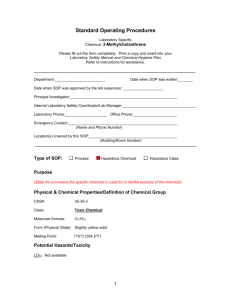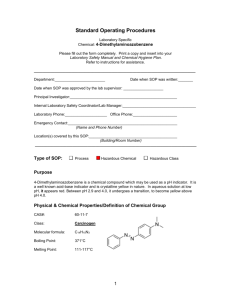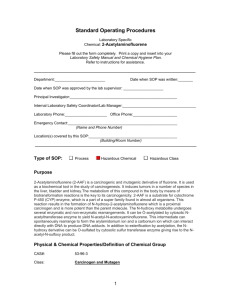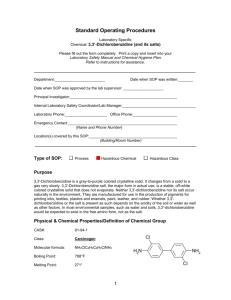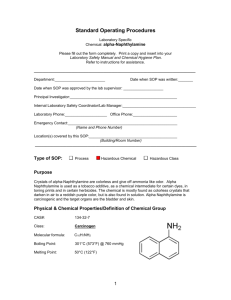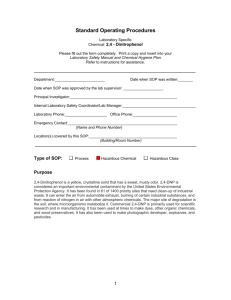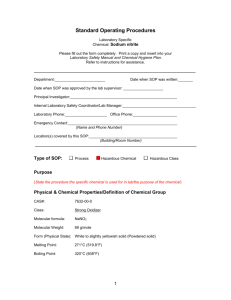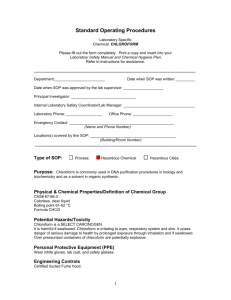UCLA - Environmental Health & Safety
advertisement
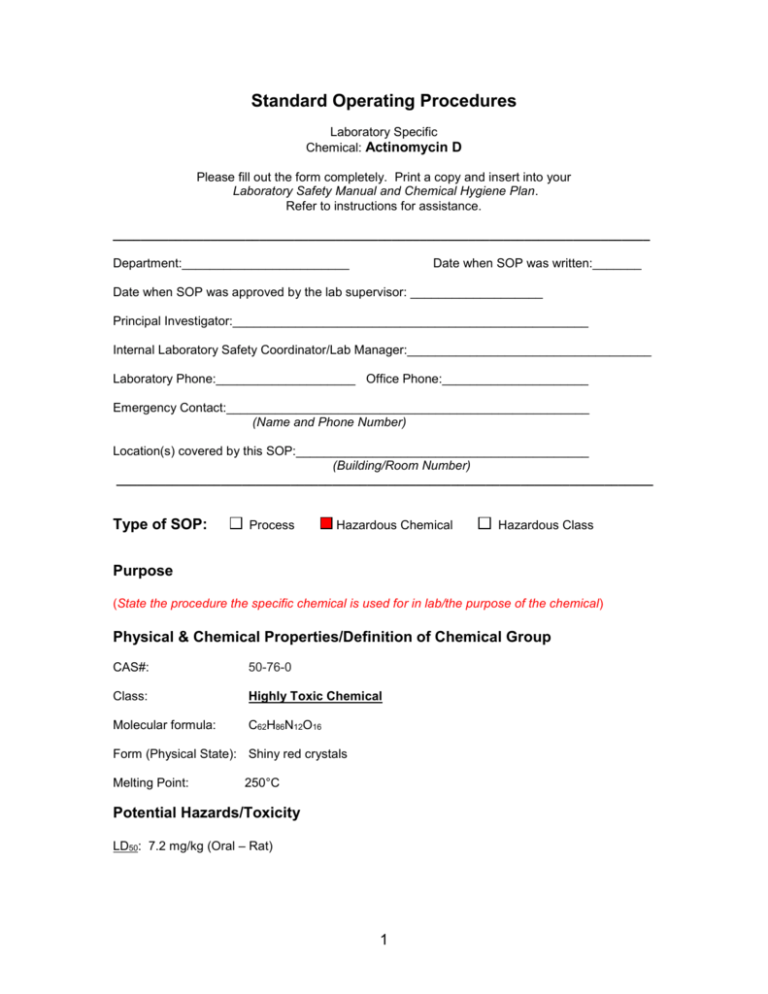
Standard Operating Procedures Laboratory Specific Chemical: Actinomycin D Please fill out the form completely. Print a copy and insert into your Laboratory Safety Manual and Chemical Hygiene Plan. Refer to instructions for assistance. _____________________________________________________________________________ Department:________________________ Date when SOP was written:_______ Date when SOP was approved by the lab supervisor: ___________________ Principal Investigator:___________________________________________________ Internal Laboratory Safety Coordinator/Lab Manager:___________________________________ Laboratory Phone:____________________ Office Phone:_____________________ Emergency Contact:____________________________________________________ (Name and Phone Number) Location(s) covered by this SOP:__________________________________________ (Building/Room Number) _____________________________________________________________________________ Type of SOP: Process Hazardous Chemical Hazardous Class Purpose (State the procedure the specific chemical is used for in lab/the purpose of the chemical) Physical & Chemical Properties/Definition of Chemical Group CAS#: 50-76-0 Class: Highly Toxic Chemical Molecular formula: C62H86N12O16 Form (Physical State): Shiny red crystals Melting Point: 250°C Potential Hazards/Toxicity LD50: 7.2 mg/kg (Oral – Rat) 1 Inhalation: May cause respiratory tract irritation. May cause effects similar to those described for ingestion. Inhalation may produce coughing, nausea, and pulmonary edema. Ingestion: May be fatal if swallowed. May cause gastrointestinal irritation with nausea, vomiting and diarrhea. May cause loss of hearing. May cause neuromuscular paralysis. Skin Contact: May cause skin sensitization, an allergic reaction, which becomes evident upon re-exposure to this material. Eye Contact: May cause severe irritation and/or eye injury. Personal Protective Equipment (PPE) Eyes: Wear safety glasses. Skin: Wear nitrile, natural rubber, neoprene, butyl, PVC or Viton gloves. Clothing: Wear long pants, shirt, and closed toe shoes and a lab coat while handling. Respirators: Respiratory protection is not generally required. Where protection from nuisance levels of dusts are desired, use type N95 (US) or type P1 (EN 143) dust masks. A respiratory protection program that meets OSHA's 29 CFR 1910.134 and ANSI Z88.2 requirements or European Standard EN 149 must be followed whenever workplace conditions warrant respirator use. Engineering Controls Facilities storing or utilizing this material should be equipped with an eyewash facility and a safety shower. Use adequate ventilation to keep airborne concentrations low. First Aid Procedures Inhalation: Remove to fresh air. If not breathing, give artificial respiration. If breathing is difficult, give oxygen. Get medical attention. Ingestion: Never give anything by mouth to an unconscious person. If victim is conscious and alert rinse mouth with water and give 2-4 cupfuls of milk or water. Get medical attention immediately. Skin Contact: Immediately flush skin with plenty of water for at least 15 minutes while removing contaminated clothing and shoes. Wash off with soap and plenty of water. Get medical attention immediately. Wash clothing before reuse. Thoroughly clean shoes before reuse. Contaminated work clothes should be laundered by individuals who have been informed of the hazards of exposure to this substance. Eye Contact: Immediately flush eyes with plenty of water for at least 15 minutes, lifting lower and upper eyelids occasionally. Get medical attention immediately. Special Handling and Storage Requirements Handling: Wash thoroughly after handling. Remove contaminated clothing and wash before reuse. Minimize dust generation and accumulation. Do not get in eyes, on skin, or 2 on clothing. Do not ingest or inhale. Use only with adequate ventilation or respiratory protection. Storage: Store in a tightly closed container. Keep away from contact with oxidizing materials. Store in a cool, dry, well-ventilated area away from incompatible substances. Spill and Accident Procedure Carbon monoxide and/or carbon dioxide may be given off in a fire. In the event of fire, evacuate and bar further entry. Chemical Spill Dial 911 and x59797 Spill – Help contaminated or injured persons. Evacuate the spill area. Avoid breathing vapors. Eliminate sources of ignition if the chemical is flammable. If possible, confine the spill to a small area using a spill kit or absorbent material. Vacuum or sweep up material and place into a suitable disposal container. Avoid runoff into storm sewers and ditches which lead to waterways. Clean up spills immediately, observing precautions in the Protective Equipment section. Avoid generating dusty conditions. Provide ventilation. Prevent spreading of vapors through sewers, ventilation systems and confined areas. Evacuate unnecessary personnel. Keep others from entering contaminated area (e.g., use caution tape, barriers, etc.) Small (<1 L) – If you have training, you may assist in the clean-up effort. Use appropriate personal protective equipment and clean-up material for chemical spilled. Double bag spill waste in clear plastic bags, label and take to the next chemical waste pick-up. Large (>1 L) – Dial 911 (or 310-825-1491 from cell phone) and EH&S at x59797 for assistance. Chemical Spill on Body or Clothes – Remove clothing and rinse body thoroughly in emergency shower for at least 15 minutes. Seek medical attention. Notify supervisor and EH&S at x59797 immediately. Chemical Splash Into Eyes – Immediately rinse eyeball and inner surface of eyelid with water for 15 minutes by forcibly holding the eye open. Seek medical attention. Notify supervisor and EH&S at x59797 immediately. Medical Emergency Dial 911 or x52111 Life Threatening Emergency, After Hours, Weekends And Holidays – Dial 911 (or 310-825-1491 from cell phone) or contact the Ronald Reagan UCLA Medical Center (emergency room) directly at x52111 (located at 757 Westwood Plaza, enter from Gayley Avenue). Note: All serious injuries must be reported to EH&S at x59797 within 8 hours. Non-Life Threatening Emergency – Go to the Occupational Health Facility (OHF), x56771, CHS room 67-120 (This is on the 6th floor, 7th corridor, room 120. Enter through the School of Dentistry on Tiverton Drive and proceed to the “O” elevator to the 6th floor.)Hours: M F, 7:30 a.m. to 4:30 p.m. At all other times report to Ronald Regan UCLA Medical Center (emergency room) at x52111. Note: All serious injuries must be reported to EH&S at x59797 within 8 hours. 3 Needle stick/puncture exposure (as applicable to chemical handling procedure) – Wash the affected area with antiseptic soap and warm water for 15 minutes. For mucous membrane exposure, flush the affected area for 15 minutes using an eyewash station. Page the needle stick nurse by dialing 231 from a campus phone, enter 93333 when prompted and then enter your extension. Hours: M – F, 8:00 a.m. to 4:00 p.m. At all other times report to Ronald Regan UCLA Medical Center (emergency room) at x52111. Note: All needle stick/puncture exposures must be reported to EH&S at x59797 within 8 hours. Decontamination/Waste Disposal Procedure Waste disposal procedures 1. Actinomycin D waste shall be disposed of into waste containers specifically designated for actinomycin D. Examples of actinomycin D waste material include gloves, pipette tips, paper towels that have been contaminated with actinomycin D. 2. Once the waste container is full or 90 days have passed, dispose of according the UCLA EH&S hazardous waste guidelines. Decontamination of Equipment Equipment that needs to be decontaminated (for repair or change of location etc.) must be washed with soapy water and rinsed with copious amounts of water. Material Safety Data Sheet (MSDS) Location (State the location of MSDS) Hardcopy or electronic copy must be available. Online MSDS can be accessed at http://msds.ehs.ucla.edu. Protocol/Procedure (Add specific description of procedure.) Note: Any deviation from this SOP requires written approval from PI. Documentation of Training (signature of all users is required) Prior to conducting any work with the chemical, designated personnel must provide training to his/her laboratory personnel specific to the hazards involved in working with this substance, work area decontamination, and emergency procedures. The Principal Investigator must provide his/her laboratory personnel with a copy of this SOP and a copy of the chemical’s MSDS provided by the manufacturer. The Principal Investigator must ensure that his/her laboratory personnel have attended appropriate laboratory safety training or refresher training within the year. I have read and understand the content of this SOP: Name _______________________ Signature ____________________________ 4 Date ____________ _______________________ ____________________________ ____________ _______________________ ____________________________ ____________ _______________________ ____________________________ ____________ _______________________ ____________________________ ____________ _______________________ ____________________________ ____________ _______________________ ____________________________ ____________ _______________________ ____________________________ ____________ _______________________ ____________________________ ____________ _______________________ ____________________________ ____________ _______________________ ____________________________ ____________ _______________________ ____________________________ ____________ _______________________ ____________________________ ____________ _______________________ ____________________________ ____________ _______________________ ____________________________ ____________ _______________________ ____________________________ ____________ _______________________ ____________________________ ____________ _______________________ ____________________________ ____________ _______________________ ____________________________ ____________ _______________________ ____________________________ ____________ _______________________ ____________________________ ____________ _______________________ ____________________________ ____________ _______________________ ____________________________ ____________ _______________________ ____________________________ ____________ _______________________ ____________________________ ____________ _______________________ ____________________________ ____________ _______________________ ____________________________ ____________ _______________________ ____________________________ ____________ _______________________ ____________________________ ____________ 5 6
